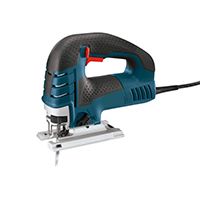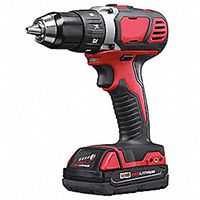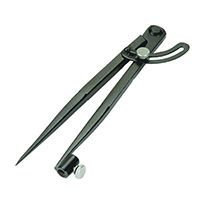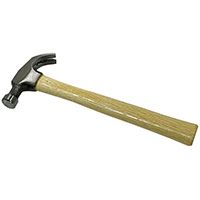Installing a tin ceiling can turn a plain room into an architectural showpiece. This classic design element adds visual interest and reflects light, making spaces feel larger and more elegant. With the right tools and techniques, you can install a tin ceiling in your home, creating a stunning focal point. This Old House expert Mark Powers details how below.
What Tin Ceilings Are Made Of
First, let’s clear up some confusion. Despite their name, most modern “tin” ceilings are actually made of steel. These panels come in various finishes, including powder-coated options that mimic the look of different metals or bare steel that can be painted. The steel used is heavy-duty, ensuring durability and a long-lasting installation. Historically, tin was used because it was lightweight and easy to emboss, making it ideal for intricate designs. Today’s steel panels retain these visual qualities while offering better durability.
Some manufacturers offer aluminum panels as an alternative. Aluminum panels are lighter and more rust-resistant, making them a good option for areas with high humidity.
Tools and Materials Needed to Install a Tin Ceiling
To install a tin ceiling, you’ll need the following tools and materials:
- 2 1/2-inch decking screws
- 4-foot level
- Brad nailer
- Brad nails
- Chalk line
- Circular saw
- Compass
- Cornice pieces
- Drill/driver
- Hammer
- Jigsaw
- Plywood sheets
- Tin ceiling panels
- Tin snips
- Work gloves
A stud finder is also helpful for locating joists, and a miter saw helps cut precise angles on cornice pieces. Safety goggles and a dust mask are recommended for protection during cutting and drilling. Use caution when using sharp tools or ladders.
Measuring Your Room and Ordering Supplies
Accurate measurements are important for ordering materials. Measure your ceiling’s length and width, then multiply these numbers to get the square footage. When ordering panels, add 10% to account for waste and cuts. Most manufacturers will calculate the number of panels and cornice pieces needed based on your room measurements and configuration.
Beyond just measuring the ceiling’s dimensions, look at the panel layout. Decide whether you want a centered or offset pattern, as this will affect the amount of panels you need. Make sure to communicate these details to the supplier to ensure you receive enough materials.
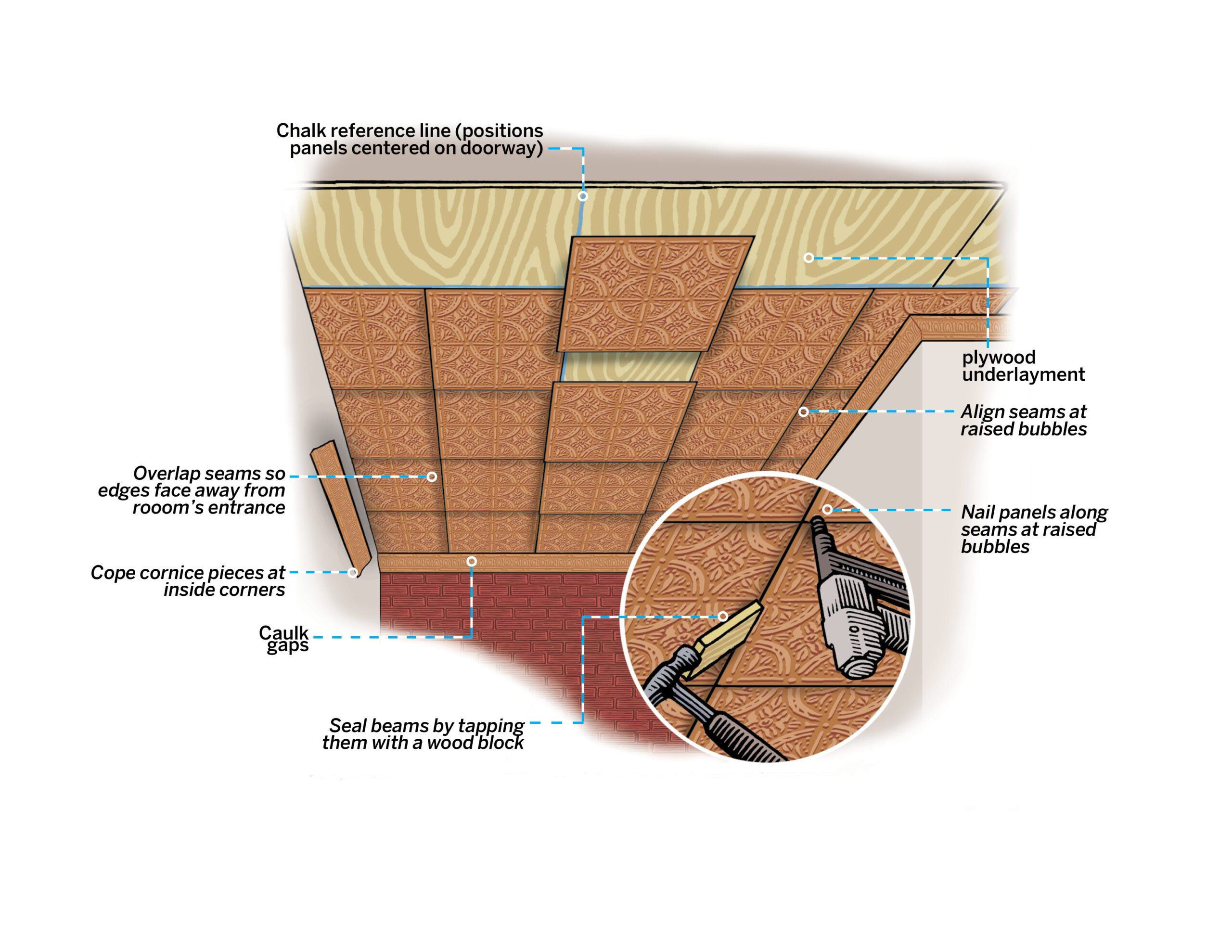
How To Install Plywood Underlayment
Before installing the tin panels, you need to create a secure base with plywood underlayment. Heavy steel panels aren’t secure when attached directly to drywall or plaster.
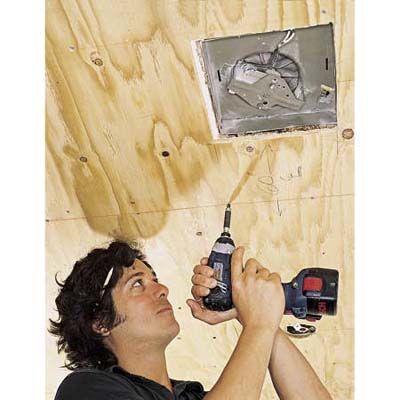
Finding and Marking Ceiling Joists
Start by turning off the power to the room at the circuit breaker and removing any ceiling fixtures. Use a drill with a 1/8-inch bit to make exploratory holes to find a joist. Once you locate a joist, mark its center and measure across the ceiling in 16-inch increments to find the others. Snap chalk lines along the center of each joist and mark their locations on the walls.
Using a stud finder can make finding joists easier. Mark each joist accurately on both the ceiling and the walls, ensuring you know exactly where to anchor the plywood sheets.
Cutting and Securing Plywood Sheets
Cut plywood sheets to fit your ceiling, making cutouts for electrical boxes and fixtures as needed. Use the chalk lines as guides to secure the plywood to the joists with 2 1/2-inch decking screws spaced every 8 inches. If working alone, a T-shaped brace made from 2-by-4s can help hold the plywood in place while you secure it.
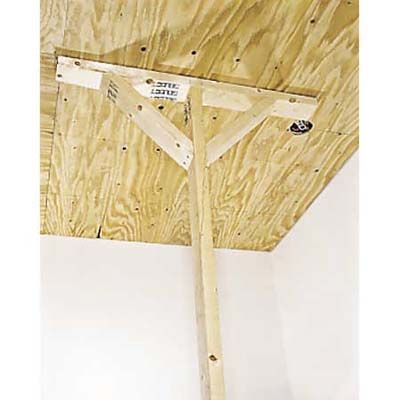
For large rooms, we recommend installing one section of plywood at a time for better stability and alignment. When cutting around obstacles like light fixtures, make the openings slightly smaller and refine the cuts as needed for a perfect fit.
Laying Out Your Tin Ceiling Design
Take time to plan your design so that the panels are centered and aligned correctly. For the best visual impact, center a row of panels over the room’s main entrance. Locate the midpoint of the doorway and measure 1 foot (half the width of a panel) to one side. This will be your starting point for the layout
Marking Layout Lines
From your starting point, snap a chalk line perpendicular to the doorway across the ceiling. This line helps center a row of panels over the door. Find the midpoint of this line and use a square to mark a perpendicular line across the width of the room. These two lines will guide the placement of your first panel.
Ensuring your layout lines are perfectly square will help prevent alignment issues later. Double-check all measurements and adjust as necessary before beginning panel installation.
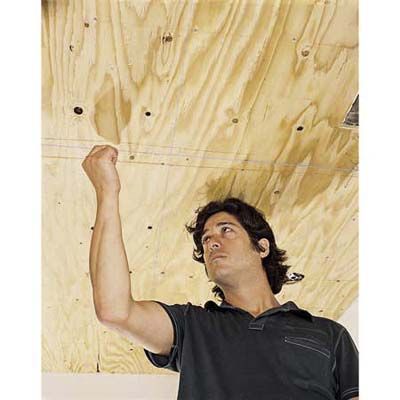
Installing Tin Ceiling Panels
With your layout lines in place, you can begin installing the tin ceiling panels. This process requires attention to detail and patience for a seamless look.
Nailing Up the First Panel
Align the corner of your first panel at the intersection of your layout lines. Using a brad nailer, fasten it to the plywood every 6 inches along the edge, angling the nails slightly. Leave one or two sides unfastened to allow for overlapping with the next panels.
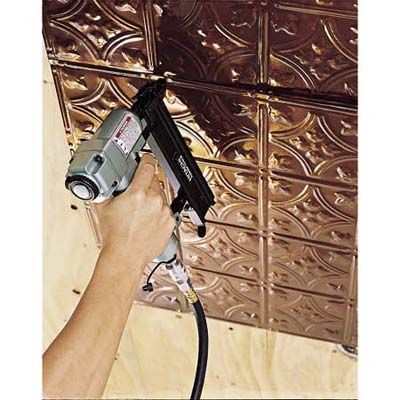
Overlapping and Securing Subsequent Panels
Tin ceiling panels have raised bubbles along their edges, creating a perfect 1/4-inch overlap. Tuck the edge of the second panel under the first, lining up the bubbles. Nail through both layers of metal at the bubbles. Continue this process, working your way across the ceiling.
When overlapping panels, it’s helpful to enlist another person to hold the panels in place while you secure them.
Cutting Panels To Fit Around Obstacles
When you encounter obstacles such as light fixtures, use a fine-point marker and straightedge or compass to draw the outline on the panel. Cut the panel slightly smaller than the opening, allowing you to bend the excess metal over the plywood edge for a clean finish. Use tin snips to make the cuts, starting with a 3/8-inch drill hole for easier access.
Take your time with these cuts, as precise trimming will result in a cleaner look and less finishing work later. Practice on a scrap piece of panel if needed to perfect your technique.
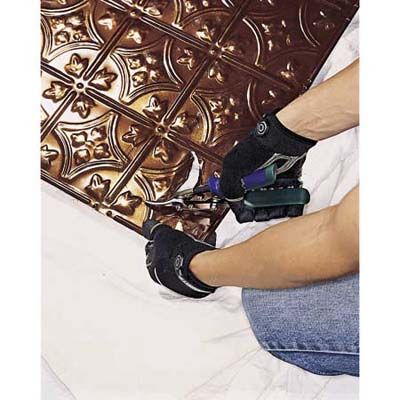
Adding the Finishing Touches
The final steps in your tin ceiling installation involve sealing seams, installing cornice pieces, and optionally painting the ceiling for a cohesive look.
Sealing Panel Seams
To ensure a tight fit between panels, use a short 1-by-4 block held at a 45-degree angle against the thin groove at panel seams. Gently tap the block with a hammer to close any small gaps, being careful not to damage the raised dimples.
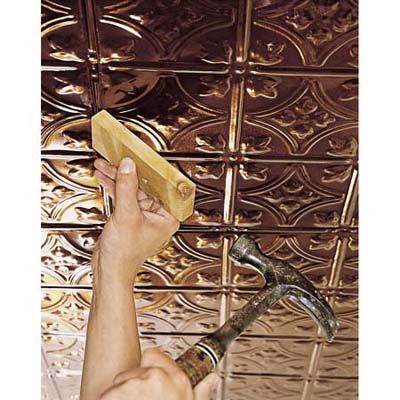
Installing Cornice Pieces
Cornice pieces bridge the gap between the ceiling and walls, creating a polished look. Lay out the precut pieces on the floor to determine their arrangement. Use a level to mark a reference line around the room for consistent placement. Install the pieces using brad nails, starting with square-cut pieces and fitting coped or mitered pieces at corners as needed.
When fitting pieces at corners, use a miter box or power miter saw to ensure accurate angles. Dry-fit all pieces before securing them in place to ensure a precise fit.
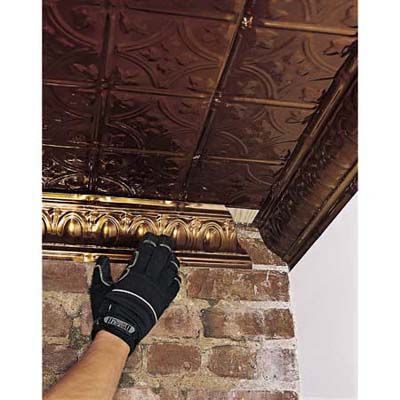
Caulking and Painting (If Desired)
For a seamless appearance, caulk any visible gaps between panels or cornice pieces. If you’ve chosen unpainted panels, you may want to prime and paint the entire ceiling for a more uniform look. This allows you to cover any imperfections in the installation.
Choose a paint that is designed for metal surfaces to prevent chipping or peeling. A spray paint designed for fine details may offer better coverage and an even finish.
Troubleshooting Common Issues
You may encounter some challenges during your tin ceiling installation. Here are our suggested solutions to common issues.
Dealing With Uneven Ceilings
If your ceiling is slightly uneven, you may notice gaps between panels. Use clear silicone caulk to fill small gaps. Use a paintable caulk if you plan to paint the ceiling. For larger discrepancies, you may need to adjust the plywood underlayment or use shims to create a level surface.
If the ceiling is significantly uneven, consult with a professional to correct the issue before proceeding. It takes more investment, but it will make a substantial difference in the final result.
Fixing Gaps and Misalignments
If you notice gaps or misalignments after installing several panels, don’t panic. Just carefully remove the nails from the affected panels and realign them. Use a straightedge to ensure proper alignment before resecuring the panels.
Regularly check alignment as you install each panel. Small adjustments made early can prevent bigger issues later.
Tin Ceiling Cleaning Tips
Regularly dust your tin ceiling with a soft, dry cloth or use a vacuum with a soft brush attachment. For deeper cleaning, use a mild soap solution and a soft cloth, being careful not to saturate the panels. Always dry the ceiling thoroughly after cleaning.
Avoid using abrasive cleaners or scrubbers, as they can damage the finish. For stubborn stains, apply a gentle cleaning solution and let it sit for a few minutes before wiping it clean.
If you notice any signs of rust, address them promptly. Clean the affected area with a rust remover, then touch up with paint designed for metal surfaces. For dents or other damage, consult a professional restoration service specializing in tin ceilings.


